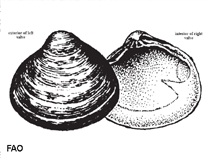Polymesoda caroliniana (Bosc, 1801)
Carolina marshclam| Native range | All suitable habitat | Point map | Year 2050 |

|
| This map was computer-generated and has not yet been reviewed. |
| Polymesoda caroliniana AquaMaps Data sources: GBIF OBIS |
Classification / Names Common names | Synonyms | CoL | ITIS | WoRMS
Bivalvia | Venerida | Cyrenidae
Environment: milieu / climate zone / depth range / distribution range Ecology
Benthic; brackish; depth range 0 - 2 m (Ref. 83435). Tropical; 37°N - 18°N, 97°W - 75°W
Distribution Countries | FAO areas | Ecosystems | Occurrences | Introductions
Western Atlantic: Virginia, USA to Campeche Mexico.
Length at first maturity / Size / Weight / Age
Maturity: Lm ? range ? - ? cm Max length : 4.0 cm SHL male/unsexed; (Ref. 83435)
Short description Morphology
Shell outline subtriangular, as high as long, inflated, heavy. Shell smooth, sculpture absent. Hinge with three cardinal teeth situated under umbo; 1 anterior and 1 posterior lateral tooth. Ligament long, narrow. Periostracum with minute scales, fuzzy, thin. Colour: externally dull white, internally white rarely stained with purple; periostracum glossy brown (Ref. 344).
It has a total length of 3.5 cm. Fisheries: It is consumed locally boiled, restrictions due to habitat degradation hamper exploitation in parts of area (Ref. 344). It is infaunal in mud or sandy mud in estuaries, mangrove swamps, and coastal lagoons (Ref. 344). Occurs in intertidal areas and in relatively small numbers in shallow nearshore areas (Ref. 104487).
Life cycle and mating behavior Maturity | Reproduction | Spawning | Eggs | Fecundity | Larvae
Members of the class Bivalvia are mostly gonochoric, some are protandric hermaphrodites. Life cycle: Embryos develop into free-swimming trocophore larvae, succeeded by the bivalve veliger, resembling a miniature clam.
Main reference
References | Coordinator | Collaborators
Leal, J.H. 2003. (Ref. 344)
IUCN Red List Status (Ref. 130435)
CITES status (Ref. 108899)
Not Evaluated
CMS (Ref. 116361)
Not Evaluated
Threat to humans
Human uses
Fisheries: commercial
| FishSource |
Tools
More information
Internet sources
BHL | BOLD Systems | CISTI | DiscoverLife | FAO(Publication : search) | Fishipedia | GenBank (genome, nucleotide) | GloBI | Gomexsi | Google Books | Google Scholar | Google | PubMed | Tree of Life | Wikipedia (Go, Search) | Zoological Record
Estimates based on models
Preferred temperature
(Ref. 115969): 23.2 - 27.4, mean 26.2 (based on 198 cells).
Price category
(Ref. 80766):
Unknown.



